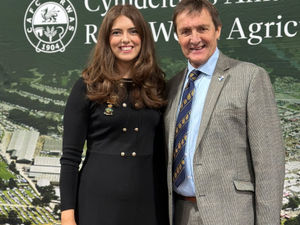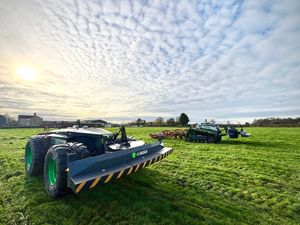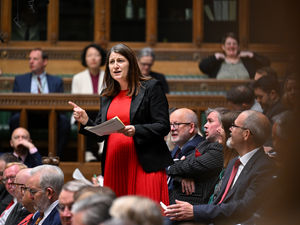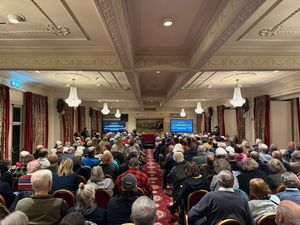Mixed farming system fits like a jigsaw
In these days of growing specialisation in modern farming, there is an adage - ‘mixed farming and muddled thinking’. But that certainly does not apply at Hopes Ash Farm where there is no mixed or muddled thinking as the each of the enterprises on this mixed family farm has been carefully planned and integrated to fit together like a jigsaw puzzle.
Farmer Robert Davies says that there was a deliberate decision back in the 70s to diversify within their core farming skills to spread the risk. It’s a real example of another adage ‘the sum of the whole is greater than the sum of the parts’ and that’s what won Robert Davies and his family The Farmers Weekly Mixed Farmer of the Year Award in 2016.
Robert insists his success is down to his parents, father Brian, who still does four days a week on the farm, and mother Jean and says he has been able build on what they developed over many years. Robert’s wife Rachel is very much part of the team and plays a vital role in the business by running the office and dealing with the mountain of paper-work.
Robert’s grandfather bought the 100-acre Hope Ash Farm, a few miles from Ross-on-Wye, in the 50s having previously farmed 32 acres further up the valley. Brian was able to join his father and take the reins while he was still fairly young and likewise Robert became a partner in the business in 1992 the year after he finished at Hartpury College and now has a free hand in running the farm.
Since buying Hope Ash Farm the family have expanded, buying more land and now owns some 300 acres, including a 35-acre cider fruit orchard producing fruit under contract to Gaymers, and rent around another 100 acres, some on short-term lets and some on grazing arrangements with a neighbouring arable farmer.
Due to its topography, a lot of the land is unsuitable for cropping and much of the grassland is too steep to mow, so is used to graze dry cows, dairy young-stock, beef cattle and sheep. The arable areas are farmed in a rotation of winter wheat, winter barley and spring beans or maize, with a grass break of 2 or 3 year ryegrass red clover leys. The cereals and beans are fed on the farm
Robert lays great emphasis on the value of a good arable/grass rotation to maintain soil fertility and reduces problems with weeds and disease. The spring beans and maize follow stubble turnips planted after the barley has been cleared, which he says is a good entry for the spring sown crops. To improve the soils and reduce fertiliser costs all the muck from the cattle yards and from the turkey house is spread on the arable land, with the first slurry spreading done fairly early in the year, with more spread after silaging.
About 160 ewe lambs are purchased each September and sold as yearlings the following August, with the main objective of running sheep is to integrate them into managing the grassland.
The big breakthrough came when they installed two Lely Astronaut Robotic milkers some eight years ago. Robert makes the point they no longer have to employ someone to milk the cows.
They run around 100 cows, mostly Friesian-Holstein, but with some Simmental crosses which besides being part of the milking herd are crossed with beef bulls to produce cross bred beef cattle. The best Simmental cattle are sold in Ross market and some meat is sold direct through a box scheme.
The milking herd, averaging around 10,000 litres, are housed virtually all the time in a cubicle house and fed a mix of grass and maize silage plus home grown cereals and beans through a Kuhn Euro mixer wagon. The silage is clamped in a covered pit and to make sure quality is not compromised, they do the whole silage making operation using their own equipment having invested in New Holland FX 28 self-propelled forage harvester, with mowing and rowing-up machinery to match its output. To keep the silage face tidy and free from spoilage, it is cut out with a McHale shear-grab on a JCB TM320 telescopic loader
As part of their diversification they moved into producing turkey stags in 1991, producing 30,000 in three crops a year in two sheds. The 40 days poults come in at 1.8kgs and ready to kill at 18kgs in 130days. They are fed proprietary pellets, blended with an increasing amount of home grown wheat as the turkeys grow.
But what of Brexit?
The family have always been keen on enhancing the farm’s biodiversity. This was recognised when they won the Herefordshire FWAG Conservation Award and were shortlisted for the Country Life Silver Lapwing Award and with on-going environmental schemes in place, they should be able to adapt. Their integrated mix of enterprises, including income from a building conversion heated by a biomass boiler using wood from the farm plus the 100kw solar panel array on a large cattle shed, will reduce risk and buffer them against the likely changes.
Robert and Rachel have a daughter Lucy and son Harry who is showing a great interest in the farm, so perhaps he will become the fourth generation to farm Hope Ash.





